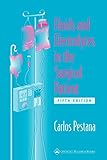Fluid and Electrolyte Therapy
|
Osmosis — passive transport of water across a semipermeable membrane. Water tends to move across the membrane until the solute concentration (the amount of solids) on both sides are the same. When water concentration is high in one compartment, there will be a net diffusion of water into the other compartment and also a diffusion of solutes to equalize the osmolarity in the two compartments. The volumes will not change.
Distribution of Fluids 1. Blood plasma (intravascular volume) (the fluid outside cells or extracellular fluid) 2. Interstitial fluid (the fluid outside cells or extracellular fluid) 3. Intracellular fluid (the fluid inside cells) Normal Body Water Distribution Dehydration Approximately 90% of the body’s water intake comes via the gastro-intestinal tract. The remaining 10% is called metabolic water and is produced as the result of various chemical reactions in the cells of the body’s tissues. Once an ingested meal enters the GI tract, fluids shift from the plasma, making the contents isotonic. Water movement into and out of the GI tract follows the osmotic gradients created by electrolyte movement. For this reason, providing solid food to a dehydrated animal is contradicted, and could prove fatal.
Estimating the percentage dehydration based upon physical
Fluid Replacement
Category: Rehabilitation Articles
Fluid, Electrolyte, and Acid-Base Disorders in Small Animal Practice (Fluid Therapy In Small Animal Practice)24% OffPractical Guidelines on Fluid Therapy 2024 Third Edition: Complete Monogram on Fluid, Electrolytes, and Acid-Base Disorders$45.00 (as of April 18, 2024 07:56 GMT -04:00 - More infoProduct prices and availability are accurate as of the date/time indicated and are subject to change. Any price and availability information displayed on [relevant Amazon Site(s), as applicable] at the time of purchase will apply to the purchase of this product.)Fluids and Electrolytes in the Surgical PatientFluids & Electrolytes Made Incredibly Easy! (Incredibly Easy! Series®)Practical Guidelines on Fluid Therapy$15.97 (as of April 18, 2024 07:56 GMT -04:00 - More infoProduct prices and availability are accurate as of the date/time indicated and are subject to change. Any price and availability information displayed on [relevant Amazon Site(s), as applicable] at the time of purchase will apply to the purchase of this product.) | ||||||||











